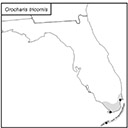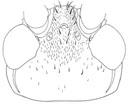|
Song at 25°C:
|
Brief chirp repeated at 0.5–2 sec. intervals. Chirps have 2–3 pulses at 40 p/s. Carrier frequency drops more than 1 kHz at lower temperatures.
|
|
Identification:
|
Length 17–21 mm. Ocellar diameter less than distance between lateral and median ocellus; conical projections at each ocellus; some bristles longer than 0.1 mm on head behind lateral ocelli. Facial pattern varies but if there is a median light area it does not reach the epistomal suture. Stridulatory file has 110–130 teeth.
|
|
Similar species:
|
(1) False jumping bush cricket (O. luteolira)—no conical projections at lateral ocelli; stridulatory file has 66-82 teeth. (2) Keys bush cricket (O. diplastes)—no conical projections at ocelli; stridulatory file has 125–145 teeth.
|
|
Habitat:
|
Mangroves and subtropical hammocks.
|
|
Season:
|
Probably year-round (records are for Mar.–Aug. and Dec.).
|
|
More information:
|
Subfamily Eneopterinae, genus Orocharis.
|
|
Nomenclature:
|
OSF (Orthoptera Species File Online).
|










